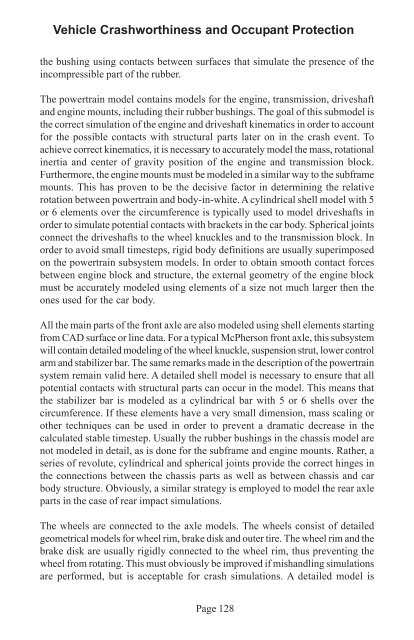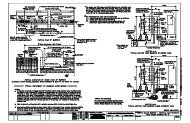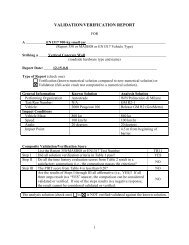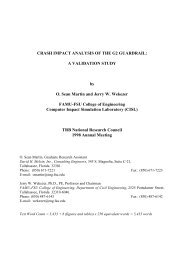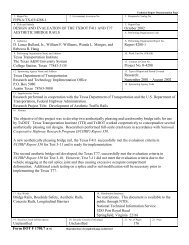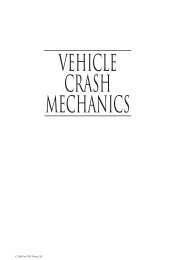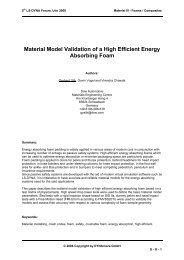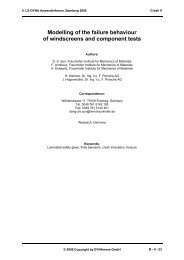Vehicle Crashworthiness and Occupant Protection - Chapter 3
Vehicle Crashworthiness and Occupant Protection - Chapter 3
Vehicle Crashworthiness and Occupant Protection - Chapter 3
You also want an ePaper? Increase the reach of your titles
YUMPU automatically turns print PDFs into web optimized ePapers that Google loves.
<strong>Vehicle</strong> <strong>Crashworthiness</strong> <strong>and</strong> <strong>Occupant</strong> <strong>Protection</strong><br />
the bushing using contacts between surfaces that simulate the presence of the<br />
incompressible part of the rubber.<br />
The powertrain model contains models for the engine, transmission, driveshaft<br />
<strong>and</strong> engine mounts, including their rubber bushings. The goal of this submodel is<br />
the correct simulation of the engine <strong>and</strong> driveshaft kinematics in order to account<br />
for the possible contacts with structural parts later on in the crash event. To<br />
achieve correct kinematics, it is necessary to accurately model the mass, rotational<br />
inertia <strong>and</strong> center of gravity position of the engine <strong>and</strong> transmission block.<br />
Furthermore, the engine mounts must be modeled in a similar way to the subframe<br />
mounts. This has proven to be the decisive factor in determining the relative<br />
rotation between powertrain <strong>and</strong> body-in-white. A cylindrical shell model with 5<br />
or 6 elements over the circumference is typically used to model driveshafts in<br />
order to simulate potential contacts with brackets in the car body. Spherical joints<br />
connect the driveshafts to the wheel knuckles <strong>and</strong> to the transmission block. In<br />
order to avoid small timesteps, rigid body definitions are usually superimposed<br />
on the powertrain subsystem models. In order to obtain smooth contact forces<br />
between engine block <strong>and</strong> structure, the external geometry of the engine block<br />
must be accurately modeled using elements of a size not much larger then the<br />
ones used for the car body.<br />
All the main parts of the front axle are also modeled using shell elements starting<br />
from CAD surface or line data. For a typical McPherson front axle, this subsystem<br />
will contain detailed modeling of the wheel knuckle, suspension strut, lower control<br />
arm <strong>and</strong> stabilizer bar. The same remarks made in the description of the powertrain<br />
system remain valid here. A detailed shell model is necessary to ensure that all<br />
potential contacts with structural parts can occur in the model. This means that<br />
the stabilizer bar is modeled as a cylindrical bar with 5 or 6 shells over the<br />
circumference. If these elements have a very small dimension, mass scaling or<br />
other techniques can be used in order to prevent a dramatic decrease in the<br />
calculated stable timestep. Usually the rubber bushings in the chassis model are<br />
not modeled in detail, as is done for the subframe <strong>and</strong> engine mounts. Rather, a<br />
series of revolute, cylindrical <strong>and</strong> spherical joints provide the correct hinges in<br />
the connections between the chassis parts as well as between chassis <strong>and</strong> car<br />
body structure. Obviously, a similar strategy is employed to model the rear axle<br />
parts in the case of rear impact simulations.<br />
The wheels are connected to the axle models. The wheels consist of detailed<br />
geometrical models for wheel rim, brake disk <strong>and</strong> outer tire. The wheel rim <strong>and</strong> the<br />
brake disk are usually rigidly connected to the wheel rim, thus preventing the<br />
wheel from rotating. This must obviously be improved if mish<strong>and</strong>ling simulations<br />
are performed, but is acceptable for crash simulations. A detailed model is<br />
Page 128


